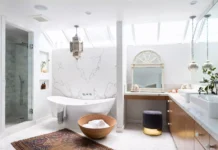As soon as Fixer Upper premiered on HGTV, the shiplap trend took off. The “modern farmhouse” design became highly sought after throughout the country, and shiplap was the star of the show. This versatile material remains on-trend, and it can be a wonderful design tool when used strategically. Let’s explore the pros and cons of using shiplap in a kitchen design.
The Benefits of Shiplap
Shiplap can transform a boring flat wall into a dynamic, textured masterpiece. Homeowners love the added contrast it provides, and designers like its versatility. Shiplap is also inexpensive, depending on how much space you’re trying to cover. It is a great option for an accent wall or small room that might look ‘boring’ with a basic coat of paint.
Reasons to Avoid Shiplap in a Kitchen
Even though shiplap looks beautiful in pictures, it isn’t exactly practical. One of the biggest complaints homeowners have about shiplap is that it creates pockets for dust to collect. The seams between the boards are tiny shelves for dust to settle onto, creating a tedious task for spring cleaning. In a kitchen, dust might collect even faster because of the oils and moisture in the room.
Speaking of moisture, the temperature and humidity changes in a kitchen may warm the shiplap over time. This, combined with the tricky cleaning, means that shiplap is a bad backsplash choice. You can incorporate it in other parts of the kitchen, but don’t use it as a substitute for tile. You’re going to end up regretting that decision the first time you cook a meal.
Lastly, you need to think about how much space you realistically have in your kitchen. If you’re trying to use it on a tiny wall just because it’s trendy, you’re probably better off without it. Take a ‘less is more’ approach with kitchen design, especially in the early stages. You can always add features to the design later on.
Smart Ways to Incorporate Shiplap in a Kitchen Design
Just because there are drawbacks to shiplap in a kitchen doesn’t mean you can’t use shiplap in your design. You can still enjoy the visual interest shiplap creates without sacrificing the function in your kitchen. Here are some smart ways to use shiplap in your kitchen:
- Use shiplap on the ceiling. You can paint it, stain it, or do whatever else you want to create a focal point on the ceiling. Dust and oil do not get trapped on the ceiling like they do on the walls, so you don’t have to worry about high maintenance.
- Add shiplap to an accent wall away from your cooking and prep spaces. A shiplap backsplash might be a bit of a nightmare, but a shiplap accent wall can still work great in a kitchen. Just make sure it is far enough away from the cooking and preparation areas that it isn’t at risk of looking persistently dirty.
- Keep other design elements simple. If the shiplap is going to be a major focal point in your kitchen, don’t choose a busy stone countertop or backsplash. Keep the rest of the kitchen somewhat simple so it doesn’t clash with the pattern of the shiplap.
- Be strategic with the direction of the shiplap. You could hang it vertically to make a small kitchen feel taller or hang it horizontally to draw the eye around the room. Don’t feel confined to the traditional shiplap orientation. You may like it significantly more just by changing the direction.
- Coordinate your cabinets and shiplap design. If you plan to paint the shiplap white, having white cabinets may make everything blend in with one another. Using colored cabinets or wood instead will add contrast to the space. Conversely, if you use stained shiplap on the wall, you might not want competing wood cabinets in the room.
- Explore other ways to add interest to a kitchen. Shiplap may not be right for your home, but there are plenty of other options to choose from. Wallpaper, tile, mirrored walls, decorative molding – there is no end to the possibilities.
For more information about designing your dream kitchen, contact O’Hanlon Kitchens. We are proud to offer professional kitchen design and build services in Maryland and Pennsylvania.


















